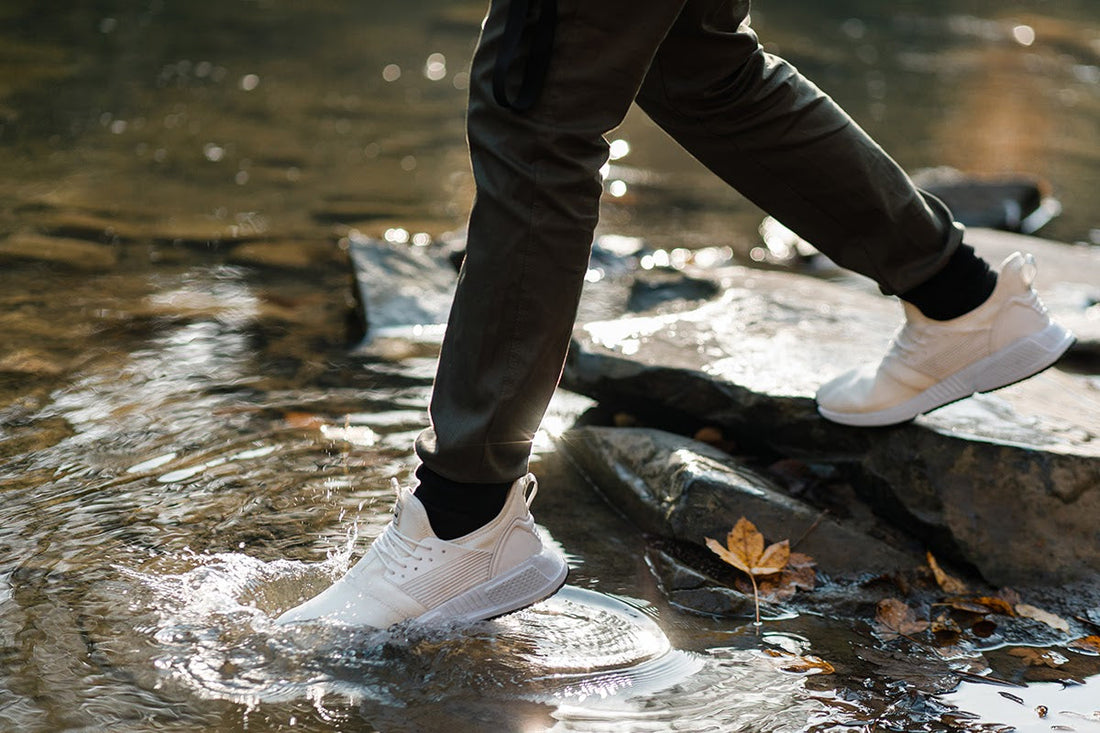When it comes to knit sneakers, many companies make big claims about completely waterproof footwear, but sometimes the shoes fail to walk the talk.
In other cases, you might want to boost your shoes’s waterproof factor. Either way, you’re probably wondering if there is a surefire way to waterproof your knit sneakers.
The answer is yes! You can use waterproof sprays and wax treatments to lay down an extra layer of protection to keep the moisture out.
So let’s get into it.
How to Waterproof Your Knit Sneakers?
Knit sneakers take really well to moisture-repellants because of their fabric. In fact, that’s the plus side about knit sneakers; the good ones can be 100% waterproof by virtue of their material alone.
Innovative technologies such as the H2-Go knit layer layer used in Loom Waterproof Sneakers ensures that your feet remain both dry and aired-out.
Ditch the Hassle of Waterproofing - Step Into Loom's 100% Waterproof Shoes for Unmatched Protection and Comfort
Still, if you’re looking for ways to waterproof your knit sneakers, wax treatments are an excellent option because the wax can easily settle in between the fabric.
Additionally, you can resort to temporary, makeshift rain covers. As they are lightweight and reusable, you will find them very convenient to waterproof your knit sneakers.
1. Waterproof Wax Treatment
It turns out that wax treatments are the best way to waterproof knit sneakers. This is because the wax can seep into the woven fibers and settle into each and every microcavity.
Then, the hardened wax seals your knitted sneakers to barricade unwanted moisture.
● DIY Waxes
While you can use store-bought waxes that are meant for waterproofing footwear, it’s easier (and cheaper) to just use beeswax, odorless paraffin wax candles, or wax beads.
Basically, you’ll rub the wax onto the surface, kind of like you’re coloring minus the stain. That’s why beeswax is perfect because it is stain-free and colorless.
● Prepping Your Shoes
The first thing you need to do is prep your shoes for the wax.
- Clean the shoes thoroughly. The wax needs a clean, fresh surface to adhere to. You can do this with a damp cloth or simply wash them to be extra safe.
- Wait for them to dry completely - this step is imperative. Wax is hydrophobic and won’t stick to damp surfaces.
- Remove the laces. This way, you’ll get easier access to all areas of the shoe.
● Applying the Wax
This is where it gets a little tricky, but believe us, the result is worth it.
- Apply some wax to a small area of the shoe. This is just to test for staining.
- Rub the wax on the outer surface of the shoe. You want to do this as thoroughly as possible. Particularly, be extra thorough around the heel, toe, sidewalls, tongue, and laces.
- Rub the wax on the laces. This is just an extra step you can choose to skip.
- Ignore the discoloration. Whether you’re using clear wax or colored wax to match the shoe, some discoloration is expected. This will go away after the process is completed.
- Use a hairdryer to melt the wax. When heated, the wax will melt and seep into every knit.
- Let it cool. The wax will harden and form a protective, impervious layer. Any initial discoloration will disappear at this point.
- Test it out. Gently pour some water onto your shoes; it should roll right off.
After this, you should be good to go. You can easily wash off the wax with hot water and soap.
2. Water-Resistant Sprays

Waterproof Sprays are the most common way to waterproof any shoes effectively. These sprays work best for absorbent fabrics, such as the ones used in knit sneakers.
The key ingredient to look out for is silicone or acrylic polymers. Beyond that, you can go with any brand you like.
Finally, be sure to do this in an open area, and wear a mask to prevent yourself from accidentally inhaling the aerosol.
Prepping Your Shoes
Waterproof sprays are fairly straightforward to use, but you still need to prep the shoes so that you can get an even coating.
- Wash and dry the shoes thoroughly. Since the spray is long-lasting, you won’t be able to wash your shoes for a good few months, at least not without washing away the spray.
- Remove the laces. Again, this is for more access to every corner of the shoe.
Applying the Spray
You need to use a proper spraying technique for an even coating. Follow these steps to get the optimal results.
- Hold the spray at least 6 inches from the shoe. If you hold it too close, you might end up saturating one spot, which will take longer to dry.
- Get all the trouble areas. These include the tongue, heel, toe, sidewalls, and seams.
- One layer is enough for knit sneakers. However, you should follow the instructions on the bottle just to be safe. Careful not to saturate the shoes, though.
- Wipe off the excess with a microfiber cloth. Gently dab the surface and get as much of the excess spray off as possible.
- Let it air dry overnight. If you get the shoes wet before the spray dries off completely, you’ll ruin all your hard work. That’s why it’s best to let them dry overnight.
And you’re done! On average, waterproof sprays will last for up to a few months. However, if you want to wash it off, you can. You can easily reapply it later.
3. Silicone or PVC Shoe Covers
If you’re looking for a more simple, short-term way to waterproof your knit sneakers, you can always use rain covers. This method isn’t nearly as involved as the other two. Plus, there’s no maintenance required.
![]()
Silicone or PVC shoe covers can completely waterproof knit sneakers since these materials are 100% impervious. They are especially useful during rainy weather.
You can simply slip them on and leave all your worries indoors. As long as you strap them on right, absolutely no water is going to trickle down your ankle or permeate the shoe.
Some Additional Tips and Precautions
When you’re waterproofing your knit sneakers, you should keep the following pointers in mind:
Break in Your Shoes Before Waterproofing
The fabric tends to stretch and move as you wear them, which means the wax or spray might be compromised. This is why you should never treat them straight out of the box.
Stay Clear of the Hairspray
Some people might recommend hair sprays as an easy DIY alternative to waterproof sprays. But the truth is they will most likely damage your shoes without making them even slightly waterproof.
Use a Damp Cloth for Cleaning
This will make the waterproof treatment last longer. Washing them will get rid of the protective layer.
Reapply the Treatment
You can reapply the treatment, but don’t overdo it. Applying a fresh layer of product every other week will reinforce the waterproofing. But if you do it too much, it might make it hard to wash off.
Note: The trouble areas are the seams, toes, heels, tongue, and sidewalls. You need to take special care of these areas to maximize the waterproofing.
Conclusion
So there isn’t anything as unpleasant as wet, cold shoes on your feet, right? Not only are they incredibly uncomfortable, but they’re also super tedious to wash and dry.
Luckily, now you know that you can waterproof your knit sneakers using so many different methods. We recommend using the DIY wax; it’s as effective as it is cheap.
And remember, always get the trouble areas of the shoe. This way, you can easily waterproof your knit sneakers and avoid squishy, drenched shoes.
FAQs
Is the Waterproofing Process Safe for All Knit Sneakers?
When considering the safety of waterproofing methods for various knit sneakers, it's important to understand that the material composition of the sneakers plays a crucial role. For instance, sneakers made with delicate or heat-sensitive materials may not respond well to wax treatments that require heat application. In such cases, opting for gentle, non-heat-based waterproof sprays could be a safer alternative. It's always advisable to test the waterproofing method on a small, inconspicuous area of the sneaker first to ensure it doesn't damage the fabric.
How Long Does the Waterproofing Last?
The durability of waterproofing treatments can vary based on the method used and the frequency of sneaker usage. Generally, wax treatments may offer a longer-lasting barrier against moisture but might require reapplication every few months, especially if the sneakers are worn regularly in wet conditions. For sprays, the reapplication might be necessary more frequently, depending on the product's quality and the level of exposure to moisture. It's important to follow the manufacturer's guidelines for reapplication to maintain optimal waterproofing effectiveness.
Will Waterproofing Affect the Appearance or Breathability of My Sneakers?
Waterproofing treatments can sometimes alter the appearance and breathability of knit sneakers. Wax treatments, while effective, may slightly change the texture of the fabric, giving it a stiffer feel. They can also affect the breathability to some extent, as the wax fills the pores of the fabric. On the other hand, high-quality waterproof sprays are designed to be less intrusive and usually do not significantly impact the breathability or appearance of the sneakers. However, they might still impart a slight sheen to the fabric. It's crucial to choose a waterproofing method that balances effectiveness with maintaining the sneakers' origin
Stop Waterproofing, Start Exploring! Loom's H2-Go Layer Technology Offers Total Waterproof Assurance with Every Step




